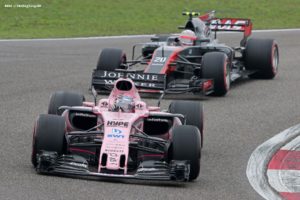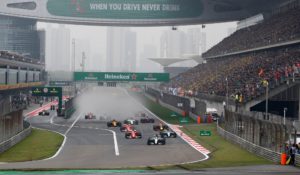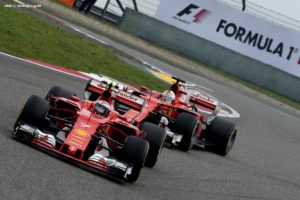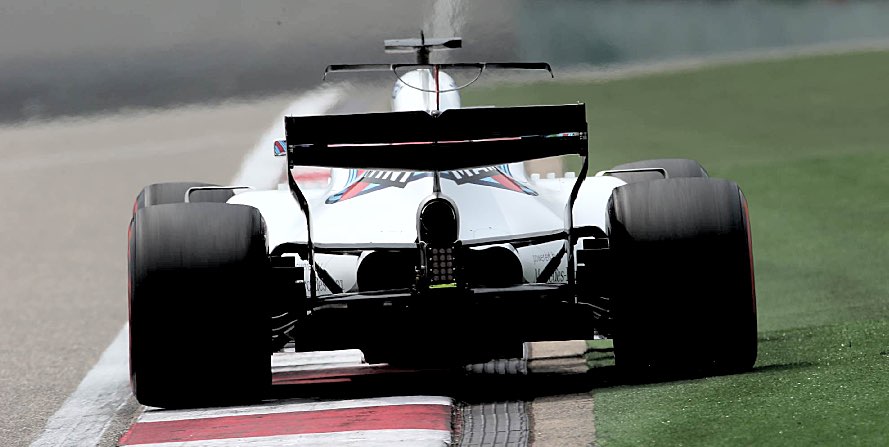After the outlier of Melbourne’s street track the Chinese Grand Prix was the first opportunity in 2017 to assess the new F1 cars on a proper race track, to judge the level of overtaking and to understand better the way that race strategy has changed with the new rules.
 There was some close wheel to wheel action and with mixed conditions at the start, decision making was at the heart of the action. In the duel between Lewis Hamilton and Sebastian Vettel, whereas in Australia it was Mercedes’ decision to pit early that cost the race, in China Ferrari took the risk to make the early stop. Their plan was thwarted, not by the early stop, but by an accident and Safety Car immediately afterwards, which handed Vettel’s rivals a free pit stop. And because the accident was on the start line, it meant that the Safety Car had to pass down the pit lane, which helped the others and made it even worse for Vettel to recuperate. It was a shame as without that, the race could have been decided between them at several different points along the way. Again the cars and lead drivers were very closely matched, with Mercedes perhaps just having the slight edge due to the cooler conditions, whereas the Ferrari was a shade faster in Melbourne. Here we will take a deep dive into the background stories from the race and analyse the decisions made and their effect on the outcome.
There was some close wheel to wheel action and with mixed conditions at the start, decision making was at the heart of the action. In the duel between Lewis Hamilton and Sebastian Vettel, whereas in Australia it was Mercedes’ decision to pit early that cost the race, in China Ferrari took the risk to make the early stop. Their plan was thwarted, not by the early stop, but by an accident and Safety Car immediately afterwards, which handed Vettel’s rivals a free pit stop. And because the accident was on the start line, it meant that the Safety Car had to pass down the pit lane, which helped the others and made it even worse for Vettel to recuperate. It was a shame as without that, the race could have been decided between them at several different points along the way. Again the cars and lead drivers were very closely matched, with Mercedes perhaps just having the slight edge due to the cooler conditions, whereas the Ferrari was a shade faster in Melbourne. Here we will take a deep dive into the background stories from the race and analyse the decisions made and their effect on the outcome.
Pre-race considerations
Practice was cut short by bad weather on Friday, which meant all the work on slick tyres was done on Saturday morning. Red Bull looked better on long runs than on qualifying runs. No–one bothered with the overly conservative medium tyre, while the Soft tyre looked like it was capable of very long stints of over 45 laps, making it a likely one stop race in the dry. However the faster warm up of the Super Soft made that an option for some.
The problem with the SuperSoft was that it forced you into two stopping, gave far less flexibility to the strategy and defined the pit stop times. That lack of flexibility could have been costly for Red Bull if it had rained later in the race, for example. For the faster cars with more downforce there was no problem getting the soft tyre to work in the cold conditions, but for the midfield and slower teams, the Supersoft was tempting.
The outlier among the faster cars was Red Bull, which saved Supersoft tyres for both drivers (Verstappen’s qualifying was disrupted so he had new tyres anyway). This is a trend we are starting to see this year for that team to seek to take the ‘fastest’ tyre, rather than the one that gives most flexibility. It almost cost them in China and it could well cost them in a future race, where flexibility is key.
What teams did not have clearly worked out due to lack of data was the crossover from the wet to the intermediate to the dry tyres, as the Pirelli wet and intermediate tyres have had little testing. This would turn out to be a pivotal issue in the early part of the race.
Carlos Sainz gambles on slicks at the start
 Most teams sent their drivers out to do a couple of laps before joining the grid on different tyres to assess the grip levels. Lewis Hamilton arrived on the grid on slicks, while others only assessed the full wets and intermediates, thinking that it was likely to be an intermediate tyre start. The problem with a drying track in Shanghai is that beneath the two giant wing structures, which span the main straight, the track stays wet for longer.
Most teams sent their drivers out to do a couple of laps before joining the grid on different tyres to assess the grip levels. Lewis Hamilton arrived on the grid on slicks, while others only assessed the full wets and intermediates, thinking that it was likely to be an intermediate tyre start. The problem with a drying track in Shanghai is that beneath the two giant wing structures, which span the main straight, the track stays wet for longer.
Although that caught out Antonio Giovinazzi, whose crash at the end of Lap 3 triggered the Safety Car, in fact the area of the track some strategists were more concerned about was the final sector, which still had some damp patches affecting lap times.
The rule of thumb is that the closer to the front you are, the more risk averse you will be in a situation like this. The further back you are the easier the decision is to go to the slick tyres. Most people did the same thing, which was to start on intermediates and pit under the Virtual Safety car on Lap 2 after Lance Stroll’s car went off. The leaders did not do this, apart from Vettel and neither did Carlos Sainz in the Toro Rosso.
Sainz, starting from 11th on the grid, took the contrary decision to start the race on slick supersoft tyres. Although he got a positive race result in 7th place, it wasn’t because of this decision. It was in spite of it. He got wheelspin off the line, dropping to 18th place and going off the track, brushing the barriers. He was lucky to get away with that and then picked up places when the Virtual Safety Car and then Safety Car came out. But prior to the Safety Car, having lost lost 27 seconds at the start, he was already a pit stop behind the others anyway. What saved him and gained the places back, was the Safety Car.
Why Vettel went for the bold strategy and why Ferrari left Raikkonen out
Ferrari qualified close to Mercedes and felt that they had a chance to win the race in China, to back up their Australia win. There’s plenty of confidence in the team at the moment and their chairman Sergio Marchionne was in the garage observing them in action.
 So when the Virtual Safefy Car was triggered on Lap 2, after Stroll’s incident, they assessed risk versus reward and went for the bold option – they pitted Vettel. Both Mercedes, both Red Bulls and Raikkonen stayed out. Ferrari now had a split strategy across the two cars. The problem was that Raikkonen had lost a place to Ricciardo at the start and sat behind him, unable to exploit the pace of the Ferrari and play his part in the game.
So when the Virtual Safefy Car was triggered on Lap 2, after Stroll’s incident, they assessed risk versus reward and went for the bold option – they pitted Vettel. Both Mercedes, both Red Bulls and Raikkonen stayed out. Ferrari now had a split strategy across the two cars. The problem was that Raikkonen had lost a place to Ricciardo at the start and sat behind him, unable to exploit the pace of the Ferrari and play his part in the game.
By pitting under the Virtual Safety Car, a stop takes around 12-14 seconds instead of 21. When the track goes green that’s a 7-9 sec gap that the leader has to build back up ahead of his own stop. As the track was drying quickly, Hamilton would surely be in a lap or two later, as would the other leading cars and Vettel could well have been in the lead (see below)
There are three main risks to doing what Ferrari did; one is that the VSC can end at any time and it would be a disaster for it to end while your car is in the pits and others get back up to racing speeds. Another is that on a cold day, if the VSC continues for a few minutes after you stop, you lost tyre temperature in the slicks and with it much of the pace advantage you’ve gone in for.
But the biggest risk is that a VSC is often followed by a real Safety Car, either because the Race Director feels that the situation requires it or because someone goes onto slicks and has a heavy accident. The latter is what happened to Vettel in China. The VSC was lifted and it was looking good for Vettel as the benchmark Sainz on supersofts was setting faster sector times than the leaders on intermediates.
Then Giovinazzi smashed into the pit wall and the Safety Car came out, which gave Mercedes, the Red Bulls and Raikkonen a free pit stop. Red Bull were especially smart here in that they could see that the Safety Car was going to be out for several laps,. So they did not ‘stack’ their cars, forcing the second car to queue behind the first for service, which is what Mercedes did, losing Bottas places to Ricciardo, Verstappen and Raikkonen. As they passed through the pit lane, the tail car Verstappen was serviced first and then the next lap through Ricciardo was serviced, so both cars gained.
Would Vettel have won without the Safety Car?
It would have been very close at Hamilton’s stop. On Lap 3, after the VSC ended, Vettel was 18 seconds behind and Hamilton needed 21 seconds to stop and retain position, so there would have been a crossover point, which could have swung either way depending on the track condition at that precise moment (a similar situation to Hamilton’s dramatic last lap world title win in Brazil 2008).
 On Lap 3, Hamilton and Vettel set similar middle sector times, but Vettel’s final sector was two seconds quicker, so it was starting to swing back towards him. Either way, if Hamilton had pitted or if he had continued and completed another lap, chances are he would have come out behind Vettel. But the Safety Car put paid to that.
On Lap 3, Hamilton and Vettel set similar middle sector times, but Vettel’s final sector was two seconds quicker, so it was starting to swing back towards him. Either way, if Hamilton had pitted or if he had continued and completed another lap, chances are he would have come out behind Vettel. But the Safety Car put paid to that.
After that Ferrari had to rely on Vettel overtaking the cars ahead of him to get back to Hamilton. They opted not to move Raikkonen out of his path and Vettel lost around 7 seconds to Hamilton as a result. This early in the season it is unusual for Ferrari to issue orders. That tends to happen only when one driver is clearly the main title challenger.
Vettel passed Raikkonen and the Red Bulls, but Ferrari opted to keep Raikkonen out on track, past the ideal stop time for his tyre condition relative to the Red Bulls and Bottas. This cost him the chance of a podium. But it wasn’t looking good anyway; had they stopped him earlier he had shown no signs of being able to overtake the Red Bulls in the first stint and would have lost a place to Bottas, who had dropped down the order because of a spin on cold tyres before the restart, so they looked at it differently.
The main reason why they left him out was to try to keep him in Hamilton’s pit window so he could be ahead after Hamilton’s stop and interfere with Hamilton’s race and bring Vettel back into play. It was the only card they had left to play. But a realistic assessment showed that it was futile. Raikkonen was inside Hamilton’s pit window on Lap 31 but by Lap 35 Hamilton had 25 seconds gap.
Raikkonen was having an off day personally and his tyres were not at their best after following Ricciardo, although it must be said the Ferrari’s benign aerodynamics mean that it can follow other cars with less damage to its tyres than any other car in the field. Vettel demonstrated that clearly in Australia and China and it could be a factor that comes into play a few times this season.
Hamilton had enough in hand so that when he pitted he came out ahead of Raikkonen. Ferrari will look to Bahrain where the hotter temperatures and layout of the track mean they could be the team to beat.


